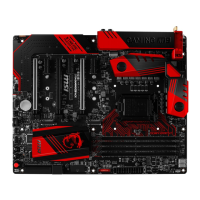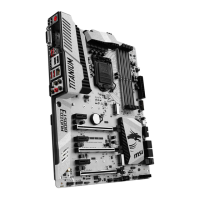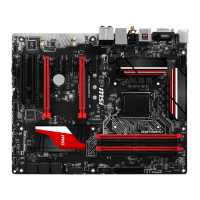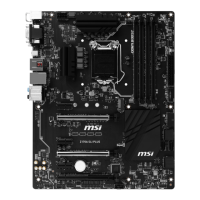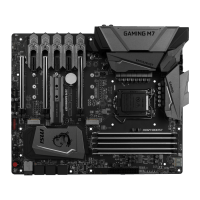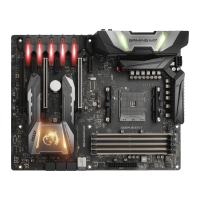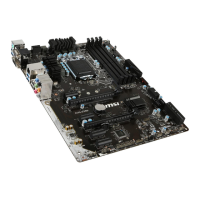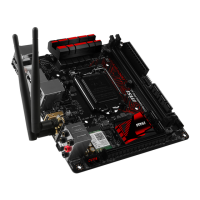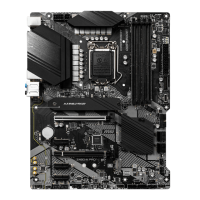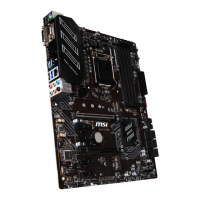
Do you have a question about the MSI Z170A GAMING M7 and is the answer not in the manual?
| Chipset | Intel Z170 |
|---|---|
| CPU Socket | LGA 1151 |
| Memory Slots | 4 x DIMM |
| Maximum Memory | 64GB |
| Form Factor | ATX |
| Audio | Realtek ALC1150 |
| M.2 Slots | 1 |
| USB 3.1 Gen1 Ports | 8 |
| PCI Express x16 Slots | 3 |
| PCI Express x1 Slots | 4 |
| RAID Support | RAID 0, 1, 5, 10 |
| Multi-GPU Support | AMD 3-Way CrossFire, NVIDIA 2-Way SLI |
| Storage Interface | 6 x SATA 6Gb/s |
| USB Ports | 8 x USB 3.1 Gen1 |
| LAN | Killer E2400 Gigabit LAN Controller |
Lists necessary tools and components for system assembly.
Details CPU, Chipset, Memory, Expansion Slots, Graphics, and Storage.
Covers RAID, USB, Audio, LAN, and internal connectors.
Outlines BIOS features and included software utilities.
Highlights gaming-oriented and MSI-exclusive features.
Explains LAN port link/activity and speed LED indicators.
Illustrates audio jack connections for different channel setups.
Introduction to the LGA 1151 CPU socket and installation.
Details on DDR4 memory slots and installation recommendations.
Information on PCI_E1 through PCI_E7 expansion slots.
Covers SATA 6Gb/s and SATAe connectors.
Explains M.2 slots and their functionality.
Describes the OC1 GAME BOOST knob for overclocking.
Details POWER1, RESET1 buttons and JPWR1~2 power connectors.
Explains JFP1, JFP2 for front panel connections.
Covers front audio (JAUD1) and USB connectors (JUSB4, JUSB1~2).
Details the JTPM1 connector for TPM modules.
Explains CPUFAN1~2 and SYSFAN1~3 fan connectors.
Covers JCI1 connector and FLASHB1 button functions.
Explains HOT_KEY1 switch and JBAT1 CMOS jumper.
Describes LED status indicators and debug code meanings.
Instructions on how to enter BIOS and use function keys.
Guides for updating BIOS and resetting settings.
Explains the EZ Mode interface and its functions.
Describes the layout and options within Advanced Mode.
Covers setting system date, time, and SATA port info.
Introduces advanced settings like PCI subsystem and ACPI.
Settings for Windows OS and secure boot functionality.
Manages boot device priority and boot mode selection.
Manages BIOS passwords and TPM settings.
Options for saving, discarding, or restoring BIOS settings.
Configures OC modes and CPU ratio for performance tuning.
Configures XMP profiles and DRAM timing parameters.
Shows system temps, fan speeds, and fan speed control features.
Explains voltage monitoring and available function buttons.
Guides for installing OS, drivers, and software utilities.
Explains Command Center interface and CPU frequency adjustment.
Details CPU fan speed control and CPU voltage adjustment.
Adjusts DRAM frequency/voltage and IGP settings.
Explains Game Boost functionality and sensor monitoring.
Guides on using Live Update for drivers, BIOS, and utilities.
Overview of Gaming App interface and the Eye Rest feature.
Configures OSD information and motherboard LED lighting.
Explains Gaming Hotkey, categories, and management tools.
Describes M-Cloud interface, server connection, and file transfer.
Guide to setting up the Soft AP feature for Wi-Fi sharing.
Covers creating, removing, and managing user accounts and permissions.
Details on creating a virtual RAM disk and its settings.
Guides on setting upload/download speeds and bandwidth control.
Explains audio profiles, effects, and microphone settings.
Details microphone settings, calibration, and effects.
Explains the HD Audio Recorder and supported software.
Lists system requirements and guides for logging into XSplit.
Explains how to stream and record gameplay using XSplit.
Details controls within the XSplit Gamecaster overlay interface.
Manages streaming services, social networks, and game settings.
Covers arranging recordings, setting hotkeys, and sharing videos.
Explains the XTU interface, navigation, and viewing options.
Details tuning controls, system tables, graphs, and monitors.
Compares different RAID levels based on drives, protection, and performance.
Guide to entering and using the IRST Option ROM for RAID setup.
Steps to delete a RAID volume and its associated data.
Procedure to revert RAID disks to a non-RAID state.
Explains degraded RAID arrays and how to re-establish data.
Steps to take when a hard drive member is missing from a RAID.
Guide to creating RAID volumes using M.2 PCIe SSDs via UEFI BIOS.
Solutions for no power, no signal, and boot failure after BIOS updates.
Troubleshooting steps for no audio, network, or USB device issues.
How to resolve lost BIOS passwords.
Compliance statements for FCC, CE, C-Tick, and battery handling.
Information on Waste Electrical and Electronic Equipment regulations.
Compliance notices for various countries like Japan, India, Turkey, etc.
Table listing hazardous substances in product components.
Copyright information and resources for technical support.
